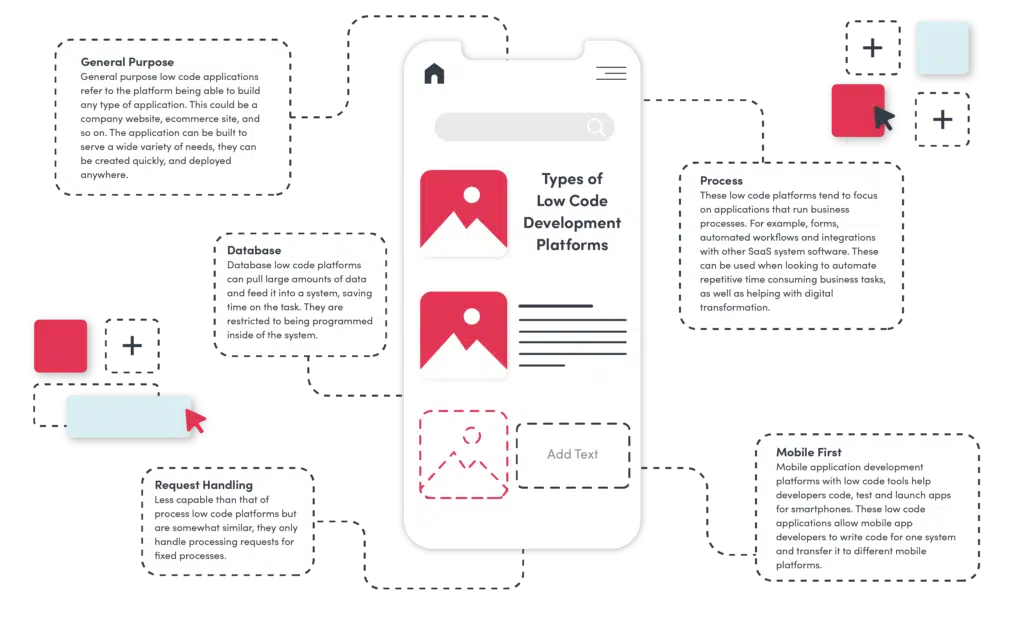Top Facts For Selecting Low-Code Platform Sites
Top Facts For Selecting Low-Code Platform Sites
Blog Article
Benefits Of Low-Code Application Development In Terms Of Integration Capabilities
Low-code applications provide significant advantages in terms of integration which is vital when developing applications that can seamlessly connect to various systems and service. These are the main benefits of pre-built connectors, APIs and other tools:
Wide Selection of Connectors. Low-code systems usually include an array of pre-built connections for business systems that are well-known (e.g. cloud-based services, databases, CRM). This simplifies the process of integrating with these systems.
API Integration: Many low-code platforms provide out-of-the-box API integration options, which allow developers to connect with external services and data sources quickly.
User-friendly:
Drag-and--Drop integration Integration tasks are typically accomplished by using drag and-drop interfaces. Developers and non-developers are able to set up complex systems that integrate without writing code.
Visual Workflow Designers: These tools assist you in understanding and implementing integrations with more ease.
Standardized Integration Methods:
SOAP and restful services that support web service standard protocols like REST and SOAP allows integration with a many different software and systems.
OData Standards and Other Standards The support for standards, like OData permits easy access to data as well as its manipulation across various platforms and apps.
Real-Time Data Synchronization:
Real-Time Integrations: Low code platforms are able to handle real-time synchronization between data systems, applications as well as databases. This will ensure that data is up-to-date and consistent within an organization.
Event-Driven architecture: Some platforms support event driven architectures. This allows apps to respond to events in real-time and is crucial for interactive and dynamic applications.
Legacy System Integration:
Low-code platforms: These platforms could be utilized to connect legacy systems to modern systems. They're an excellent option to modernize your IT infrastructure without having to overhaul everything.
Data Migration Tools Built-in data-migration tools make it simple to transfer data from older systems to applications that use low-code.
Integration of Third Party Services:
Integration with Cloud Services: Seamless integration with cloud-based services like AWS, Azure, and Google Cloud allows for the easy deployment and scaling of applications.
Business Applications Integration: Low-code platforms can integrate with various business software like Salesforce, SAP, Microsoft Dynamics, etc. to create a seamless workflow that is able to be used across various business processes.
Simplified data management:
Unified Data Modells: Some lowcode platforms offer common coding models, which make it easier to manage the management of data and integration, as well as synchronization across various systems.
Data Connectors are data connectors that have been pre-configured that offer easy access to sources of data, and allow manipulation.
Security and Compliance
Secure Integrations Low-Code platforms are designed to make sure that integrations adhere to security protocols and standards. This protects the data in transit as well as when it is stored.
These platforms are often equipped with features that help ensure conformity (e.g. HIPAA, GDPR) and provide peace of mind to businesses that handle sensitive data.
Extensibility:
Low-code platforms are able to accommodate complex integration needs by including custom scripts or code. They provide flexibility, but without sacrificing their accessibility.
Plug-in Ecosystems. A community of extensions and plug-ins can allow you to further enhance the capabilities of integration, while adding additional functions as needed.
Overall, the capabilities for integration of low-code application development platforms make them an excellent device for building efficient, interconnected and scalable apps. These platforms simplify the process of connecting different IT systems, boost the flow of information, and assist businesses to adopt the latest technologies as well as leveraging new technologies. Take a look at the top rated updated blog post for Low-code Platform for application development for site recommendations including paas service, mobile app development platforms, app platforms, application development platforms, paas service, cross platform app development, azure sql databases, app modernisation, rapid applications, push alerts and more.
Benefits Of Low-Code Application Development In Terms Of Scalability And Flexibility
The creation of low-code applications has many advantages, specifically in terms of scaling. It is crucial to create applications that grow with your business and adapt to changes. Here are a few of the main advantages.
Cloud-Based Deployment: Many low-code platforms use cloud technology which allows applications to grow seamlessly with the underlying cloud infrastructure. Businesses can handle more load without worrying too much about server administration.
Auto-Scaling: The auto-scaling feature allows you to automatically adjust resources in accordance with demand. This ensures consistent performance at peak times with no manual intervention.
Flexible Architecture:
Modular Design: Low-code systems encourage modular design of applications, in which components can be independently developed test, scaled, and then redesigned. This flexibility increases flexibility and allows to upgrade or expand certain elements of a program without affecting the overall system.
Microservices Architecture: The Microservices architecture supports the creation of applications by creating an loosely coupled collection of services. This increases both scalability & flexibility.
Customizable Solution:
Extensibility : Low-code platforms allow developers to expand capabilities beyond what is available in standard features. This enables unique business requirements to be met without restrictions.
Third-Party Integrations: Businesses can integrate additional functionality and features into their applications by integrating with APIs and third-party services.
Agile Development and Deployment
Continuous Delivery and Deployment: Low-code platforms can be used to implement agile methods, enabling continuous integration and continuous delivery (CI/CD). This allows applications to be updated and upgraded quickly and in response to user feedback.
Iterative Development: The nature of development using low-code ensures applications are able to be incrementally improved and scaled, reducing the risks of large-scale changes and allowing for more controlled growth.
Resource Optimization
Low-code platforms can analyze and monitor the performance of applications and help to optimize the use of resources. This ensures that resources are used effectively. They are also able to be scaled up or down in accordance with the actual requirements.
Load-balancing: Features that spread workloads equally across servers enhance the application’s ability to handle large traffic and ensure consistent performance.
Global Reach
Multi-Region deployment: Low-code systems typically allow deployment across multiple regions. This allows companies to offer low-latency to users from all over the world. This is essential for applications that serve an international audience.
Localization Support The built-in support for language localization enables applications to easily be adapted to different languages and regional needs and thereby allowing them to be more flexible in various markets.
Maintenance and Updates
Simple Maintenance : Low-code apps with a modular and visual design makes maintenance easier. This allows updates and bug fixes be made quickly, with no lengthy downtime.
Version Control: The integrated system for controlling version allows the safe release of rollbacks and updates. Previous versions can also be restored if they're required.
Cost Efficiency:
Low development costs. Through reducing the code requirements, low-code platform platforms cut down on the cost of development and allow applications to scale up without increasing development effort.
Pay-As.-You-Go Lowcode platforms offer flexible price models, such as pay-as.-you-go. These align costs to actual usage and growth in order to give financial flexibility.
In general, low-code development provides businesses with the flexibility and capacity they need to build robust and flexible apps. These platforms allow for rapid adjustments to meet changing requirements, efficient resource use, and continual improvement, making sure that applications expand and change in line with business needs. View the recommended Enterprise application development with Low-code Platform for blog info including cloud software applications, software for app development, app development platform, multiplatform mobile app development, cross platform mobile development, develop web application, rad application development, rapid action development, app modernization, cloud software applications and more.
Advantages Of Developing Applications Using Low-Code In Terms Of Limitations And The Possibility Of Customizing
Low-code application development is a balanced solution that offers significant benefits in addressing limitations while permitting customization. Here are a few major advantages: Handling limitations
Beating Complexity Barriers
Low-code platforms simplify development by providing templates that are pre-built and other components. This allows for rapid deployment and development of complicated applications.
Numerous platforms offer wizards and workflows with guided steps to assist developers in navigating difficult processes. These tools minimize the risk of mistakes and ensure the consistency of.
Scalability Solutions
Scalability built-in: Lowcode platforms usually include capabilities to support an scalable architecture. They enable applications to cope with increasing demands without major changes.
Performance Monitoring Tools: tools for monitoring and optimizing performance are incorporated in the application to ensure it remains efficient even as it scales.
Security and Compliance
Integrated Security Features: Low-code platforms include security features including encryption, access control based on role and automated checks for compliance to address security issues that are common.
Platforms frequently update their security and compliance measures to ensure that applications are secure against threats that change.
Customization capabilities:
Extensibility:
Low-code platforms allow developers to expand functionality beyond what is available by adding custom code.
Modifications and plugins that are custom Developers can design customized plugins or modules that provide specific features that are adapted to the specific requirements of a particular business.
APIs and Integration
API Support: Full API support permits seamless integration of other systems and services. This facilitates large customization and connection.
Third-Party Platforms: Lowcode platforms are often already built with connectors to third-party apps, making it simpler to integrate them and modify the application.
Flexible UI/UX design:
User interfaces that can be customized: Developers can modify and design user interfaces to meet specific branding requirements and requirements for usability, resulting in a tailored experience for users.
Responsive Web Design: Built-in design responsive capabilities allow applications to be customized according to the screen size and device.
The process of customizing Business Logic is easy:
Visual Workflow Builders - Visual tools to design and customize workflows, business logic and processes allow developers to develop complicated and customized processes without the need for programming.
Conditional Logic & scripting: Platforms permit the application of conditional logic and scripting that is custom-made to handle specific business rules.
Data Management:
Custom Data Modelling: Those who develop the models develop custom models to meet specific requirements for the particular application. They can customize the handling of data to meet business requirements.
Advanced Data Processing: Integration of advanced tools and capabilities to process data allows customizations in the way data is processed in an application.
How do you balance customization with limits:
Frameworks and Standards
Low-code Platforms Support Industry Best Practices and Standards: Low-code platforms encourage adhering to the industry's best standards and practices. This helps to maintain high-quality, secure, and scalable applications.
Governance Frameworks. Inbuilt frameworks for governance guarantee that modifications will not compromise security, integrity, or compliance of the application.
Iterative Development and Feedback
Rapid prototyping: Being in a position to quickly prototype and test customizations developers can improve upon user feedback to enhance the app.
Low-code platforms allow for continuous improvement, allowing for continuous customization and further enhancing as business requirements develop.
User Empowerment
Enabling Citizen Developers to Develop In allowing non-developers make customizations through simple interfaces, low-code platforms expand the pool of contributors who can improve and customize applications.
Support and training: A lot of platforms offer extensive training materials as well as support services to help users in creating customizations that work without compromising the application's performance or stability.
Low-code development is a potent framework that permits a lot of flexibility while also addressing issues. This balance ensures that businesses are able to create and maintain apps that are both functional and tailored to their specific requirements, while also maintaining the highest standards of quality, security and the ability to scale.